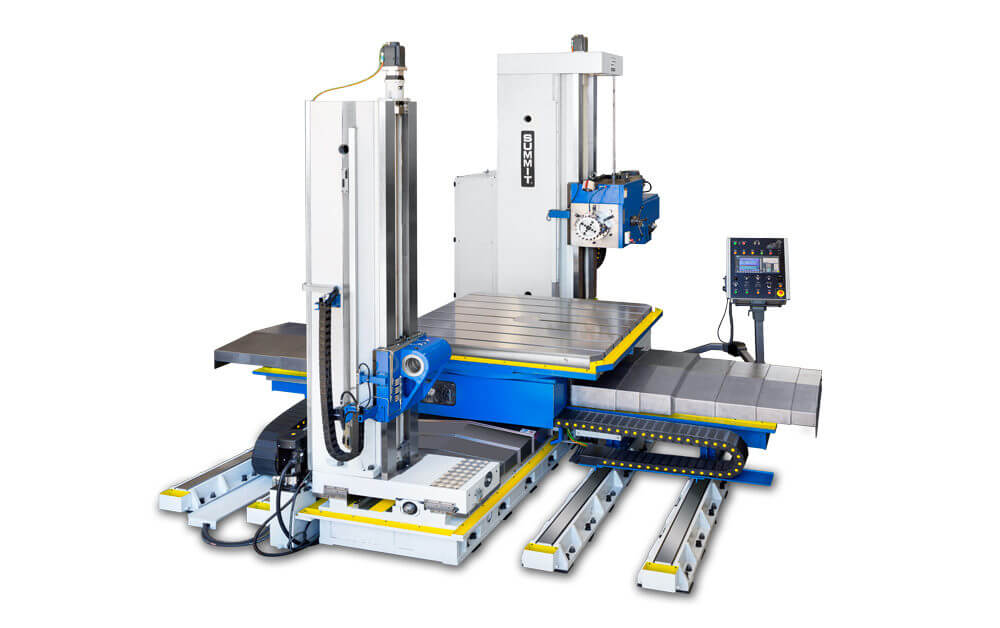When it comes to CNC machining, horizontal boring mills are a fascinating piece of equipment. These machines, designed primarily for deep hole machining, are versatile and essential in many manufacturing processes. Let’s explore what makes horizontal boring mills so unique and why they are a smart choice for machining deep holes and large parts.
What is a Horizontal Boring Mill?
A horizontal boring mill, as the name suggests, is primarily used for boring, which involves enlarging a hole that has already been drilled. These machines are quite similar to horizontal machining centers but come with their own set of unique features. One of the key distinctions is that horizontal boring mills often lack some of the automated features found in machining centers, like automatic tool changers.
Key Features and Capabilities
1. Extended Spindle (Quill): The spindle in a horizontal boring mill can extend further out than in other machines, allowing it to reach deep into parts. This is crucial for boring deep holes with high precision.
2. W-Axis Movement: In addition to the typical X, Y, and Z axes, horizontal boring mills have a W-axis. The W-axis allows for parallel movement to the Z-axis, providing extra flexibility and enabling the machining of large and hard-to-reach areas.
3. Stability and Rigidity: These machines are designed to handle large parts and provide the necessary stability and rigidity. This minimizes deflection and maintains accuracy, even when dealing with heavy and oversized workpieces.
Applications of Horizontal Boring Mills
Horizontal boring mills are indispensable in several industries, particularly for tasks that require deep hole machining and working on large, heavy parts. Here are some typical applications:
- Pump Bodies: Machining large pump bodies often requires boring deep holes and working on multiple faces of the part.
- Gearboxes: Precision boring is critical in creating the internal features of gearboxes.
- Engine Blocks: Machining deep holes and complex geometries within engine blocks is a task well-suited for horizontal boring mills.
- Heavy Equipment: Large components for heavy machinery often need the capabilities of a boring mill for both drilling and finishing.
Comparing Horizontal Boring Mills and Horizontal Machining Centers
Here’s a quick comparison to highlight the differences and unique advantages of horizontal boring mills:
| Feature | Horizontal Boring Mill | Horizontal Machining Center |
|---|---|---|
| Primary Function | Boring, deep hole machining | General machining, multiple operations |
| Spindle Extension | Extended (Quill) | Standard |
| W-Axis | Yes | No |
| Tool Changing | Manual or limited automation | Fully automated (ATC) |
| Typical Applications | Large parts, deep holes | Versatile, various parts |
| Stability and Rigidity | High | Moderate |
| Cost | Generally higher | Variable |
Practical Tips for Using Horizontal Boring Mills
- Optimize Setup: Given the large size of parts typically machined on these mills, ensure the setup is optimized to minimize movement and maximize stability.
- Tool Selection: Use the appropriate tools designed for deep hole boring to ensure precision and reduce wear.
- Regular Maintenance: Keep the machine in top condition by performing regular maintenance, especially on the spindle and quill.
- Programming: Pay special attention to the programming of the W-axis and ensure tool paths are carefully planned to avoid collisions and ensure accuracy.
Real-World Example
Imagine a company that manufactures large gearboxes for industrial machinery. They initially used horizontal machining centers but faced challenges with deep hole machining and maintaining precision across large parts. By switching to horizontal boring mills, they achieved:
- Improved Precision: The extended spindle and W-axis allowed for more precise machining of deep holes.
- Increased Efficiency: Reduced setup times and fewer re-clampings led to faster production cycles.
- Higher Quality: Enhanced stability and rigidity minimized defects, leading to higher-quality finished products.
Final Thoughts
Horizontal boring mills are a crucial asset in the world of CNC machining parts, particularly for tasks involving deep holes and large workpieces. Their unique features and capabilities make them indispensable in industries requiring precision and efficiency. By understanding and leveraging the advantages of these machines, manufacturers can significantly enhance their machining processes and product quality.
Other Articles You Might Enjoy
- Evolution of Mills and Machining Centers: The Future of CNC Machining Parts
Stepping into the world of CNC machining, you quickly realize how pivotal mills and machining centers are in crafting precise parts. Over time, these machines have evolved significantly, transforming from…
- Smart Choice for CNC Machining Parts: Comprehensive Analysis of Horizontal Machining Centers
When it comes to CNC machining parts, the type of machining center you choose can significantly impact the efficiency and quality of your work. Horizontal CNC machining centers (HMCs) are…
- Precision CNC Machining of Steel: High-Volume Production
Precision CNC Machining and High-Volume Production As an integral part of modern manufacturing processes, Precision Computer Numerical Control (CNC) machining brings about unmatched accuracy and consistency in the production of…
- Material Versatility in CNC Machining: From Titanium to Thermoplastics
Introduction to CNC Machining CNC machining stands as a cornerstone in the manufacturing sector, enabling the precise creation of parts and components. This process utilizes computer numerical control (CNC) to…
- Precision CNC Machining for High-Performance Industrial Machinery
Precision CNC Machining for High-Performance Industrial Machinery The process of Precision CNC (Computer Numerical Control) machining is at the core of manufacturing high-performance industrial machinery. This technique leverages a computer's…
- Nickel vs. Cobalt Alloys in High-Temperature CNC Machining: A Detailed Analysis?
Nickel and Cobalt Alloys in High-Temperature CNC Machining Both Nickel and Cobalt alloys play an essential role in high-temperature CNC machining. These metal alloys are popular choices due to their…









